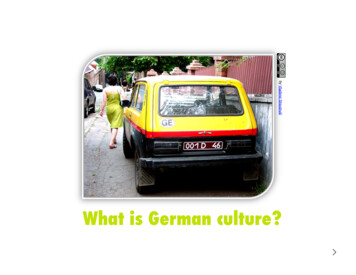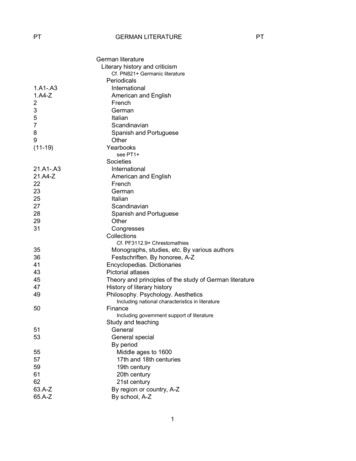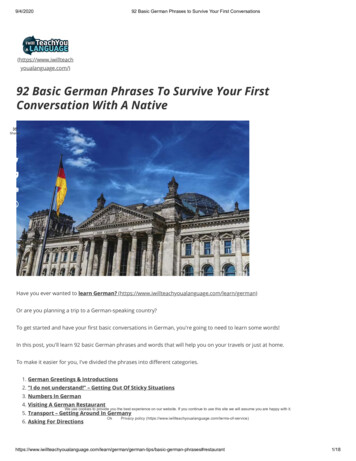
Transcription
by Vladimir Shioshvili!What is German culture?
To narrow down what weunderstand when we usethe term (German) culture,let’s look at an example: Youstep out of your plane inFrankfurt, step onto one ofthe rapid transit trains (theS-Bahn) and apart from thelanguage, Germany,at first sight, seems tolook more or less likeeveryplace else!Of course you will alsoencounter things that areuniquely German by Chris Mc RobertsPeople talking on their cellphones, listening to theiriPod and wearing more orless the same style ofclothing you find all over thewestern world. You will seeadvertisements for similarmovies, television shows,music and so on.such as Frankfurt'sdistinct architecture orsome of the local foods.
As you are exploring the city with thehelp of Frankfurt's many modes of publictransport, you happen to sit down next toa German fellow traveler and as you doso, you utter – as you would in the US –in your very best German a polite However, instead of replying, “Good,how are you?”, the other person willeither stare at you blankly or proceed totell very earnestly how s/he is doing(which might take until you havereached your final destination)!Hi! How !are you?!BLAH!!BLAH!! BLAH!!
You have just come across one of many subtle and outwardly invisible attributes that areconstitutive of what we understand as German culture. (Or you – having been aperceptive student of German culture – won't even attempt such a greeting but merelynod or smile at the person next to you as it is more common in Germany. But let'sassume for the sake of the argument that you are not .)Apparently your first attempt at communication was misunderstood and you learnedyour first lesson in German customs for interacting with strangers: Generally, Germansdo not start a conversation with strangers by asking them how they are, even if theyhappen to sit next to them in the subway. Our little fictional scene provides us with a firstworking definition of culture.
Whatisculture!?Culture is the repertoire of shared patterns of social and cognitiveconstructs which are acquired through socialization and whichregulate the interactions of the members within a group or society.Culture defined this broadlydoes not just refer to theartistic production of a societybut refers to a set of rules(explicit or not, such as laws,customs, traditions, generalknowledge, religious beliefs,myths and so on) that guidehuman interaction in aparticular society or group.
It necessarily follows that culture ism u l t i - l a y e r e d : Just as thereare a number of groups andgroups in groups in any givensociety there are a number ofcultures and cultures inside thesecultures that may or may notintersect. For example, the abilityto communicate via a language inwhich the construction ofsentences is based ongrammatical rules (verbal or signlanguage) is a trait of a universalhuman culture.A particular language such asGerman might be one of thedefining criteria of German culture.Certain German slang words thatrecently have entered the languagesystem might be a defining criteriaof German youth culture and so on.Thus, German culture should notsimply be taken as a synonym ofGerman national culture. Insideevery national culture we will find asubset of different patterns ofbehavior which will reflect a subsetof different cultures within a culture(e.g. youth cultures, cultures ofmigrants, regional cultures,business culture, soccer culture,alternative culture etc.)German culture, for thepurposes of this class, refersto this multi-layeredunderstanding of culture.
Before proceeding, please try tothink of examples, possibly fromyour own experience, reflecting themulti-layered structure of culture orof a culture within a culture.Click the light bulb toshare your ideas onWallwisher, the onlinebulletin board for thiscourse. You can evenremain anonymous!
What went wrong?Let's now recall your encounter with afellow German traveler on the tram inFrankfurt. Assuming you have learned thebasics of the German language, you arefamiliar with German geography andhistory and the most important Germanlaws and customs, why did your firstattempt at a casual everyday interactionstill end somewhat uncomfortably? Whatwent wrong when you all you tried was toutter a polite greeting? What we called inour first definition of culture a repertoire ofshared patterns of social and cognitiveconstructs does not just refer to thelanguage, laws and customs of a specificculture but more importantly how theseare interpreted. “It is their interpretation ofthe symbols, laws andcustoms that distinguishcultures from each other.”Generally speaking members of thesame culture will interpret culturalsymbols and artifacts in a more orless similar way. Our three words“How are you?” can either signify anoncommittal greeting (as in USculture) or a genuine request forinformation (as in Germany).
As an aside note, the American term Subwayhas recently entered Germany, but not inreference to a mode of transportation. In 2007,the restaurant franchise had opened manystores in Germany. Click the play button belowto watch the first German Subway commercial!
Now imagine our initialexample of possiblemiscommunication in thesubway a little differently: Inrecent decades, startingafter WWII, German cultureespecially German youthculture has been influencedby US-American culture.Today as a result of globalmovie, music, and fashionindustries aided by theadvances ofcommunicationtechnologies, more andmore elements of Germanpopular culture havebecome almostindistinguishable from USpop culture. Chances are that if youmeet a German your ownage you will have seensome of the same movies,listened to some of thesame music, follow similarblogs and tweets and youmight even have mutualFacebook friends. If theperson you chose to sit nextto on the Frankfurt subwayhappens to be your roughlyown age, chances are thats/he and you will share afair number of culturalexperiences and theirinterpretations and – afterhaving seen hundreds ofAmerican produced TVshows and movies – s/hewill recognize your attemptat a friendly greeting (andpossibly your Americanaccent) and reciprocate.
What has changed in oursecond scenario? Theinterpretation of the greetinghas changed. The definitionof culture as (sometimeschanging) interpretationenables us to describeanother important attributeof culture: the continuousflux, development andmixing of cultures.Culture is not a statusquo but a process; it isflexible and thus ableto continuously evolveinto something else. Members of a group are notonly shaped by their culturebut culture is simultaneouslytransformed by its members.Culture is nothing thatsimply is but it is perpetuallycreated and recreated. Inour little scenario with its twopossible outcomes you havejust witnessed the blendingof two cultures, thetransformation of culture atwork. With the heightenedinterest in US pop culture,younger Germans havebecome acquainted withAmerican greeting customsand have incorporated someof them into their owncultural repertoire. Onescenario, two completelydifferent outcomes basedsolely on the changinginterpretation of three wordsas simple as “How are you?”
Please try to think ofother examples how theinterpretation ofhistorical, political orcultural events canchange and possiblycreate a new culturalreality. Go back to theweek 1 folder ofBlackboard and postyour response in yourblog.
Thus far we were able to define cultures as multi-layered sets of shared cognitive constructs.People who belong to the same culture will generally interpret their cultural reality in more orless the same way. The more or less is crucial here. We have just described a scenariowhere a customary greeting of one culture has been assimilated by another. A possibleinterpretation of the phrase “How are you?” has become now that of a greeting. What makesthis transformation of culture possible, what makes culture flexible depends again on itsinterpretation: the very idea of interpretation implies ambiguity, misunderstandings.Interpretation per definition leaves room for differing outcomes.As a result, cultural patterns of interpretation are often ambiguous or even contradictory to theextent that they may become contentious. Members of a culture will more or less interprettheir reality in the same way. We see these ambiguities at work every day, not just in politicsbut virtually where and whenever people communicate. Yet, far from being destructive theseambiguities and contradictions are exactly what make cultures work: They enable thecommunication between different culture and the very transformations which keeps thosecultures alive.
For communicationbetween culturescultural transformationsgone wrong, pleaseclick the play button towatch a short clip ofthe British ComedianHarry Enfield as Jürgenthe German: As you watch, thinkabout whatstereotypes aboutGermans areaddressed. How doesthe communicationbetween cultures gowrong?You have completed lecture 1a.
German might be one of the defining criteria of German culture. Certain German slang words that recently have entered the language system might be a defining criteria of German youth culture and so on. Thus, German culture should not simply be taken as a synonym of German nati










